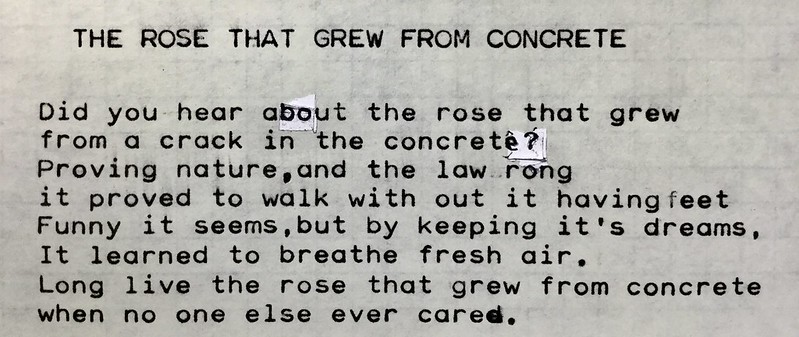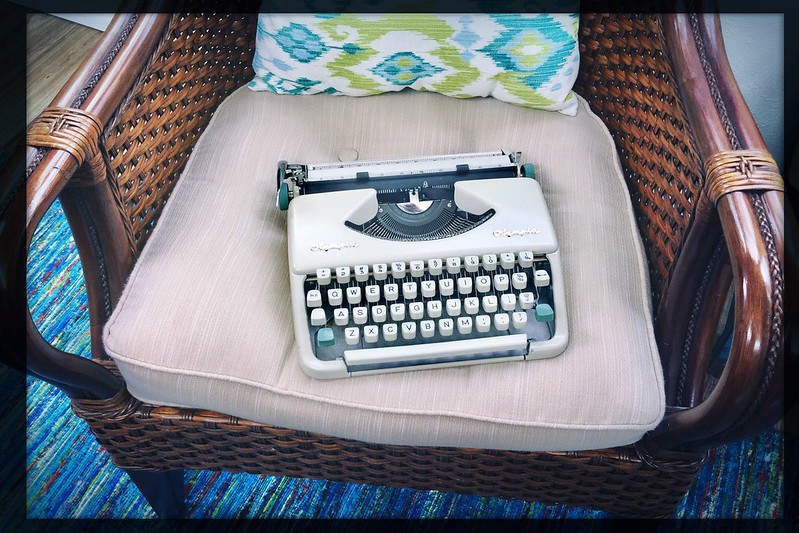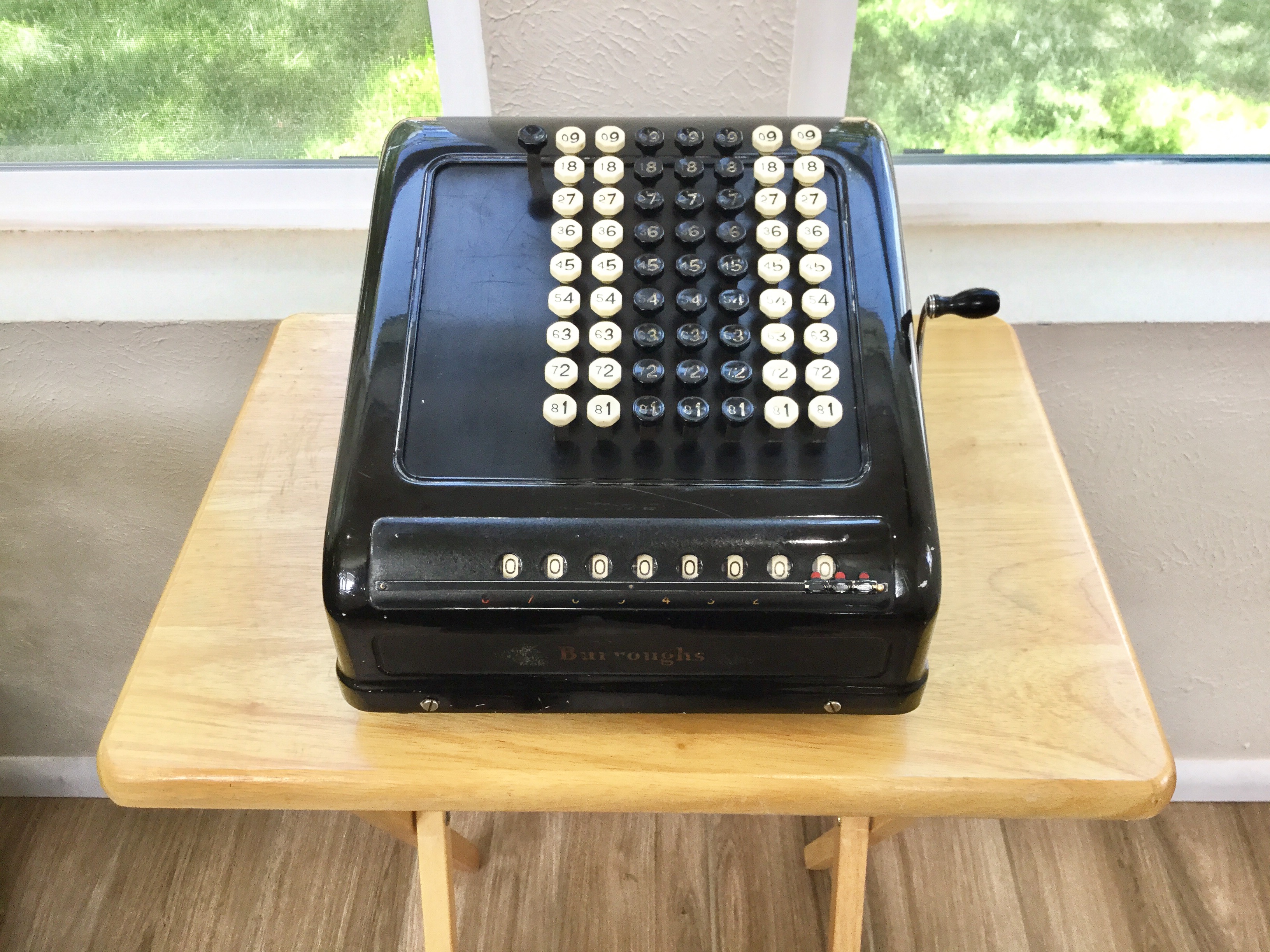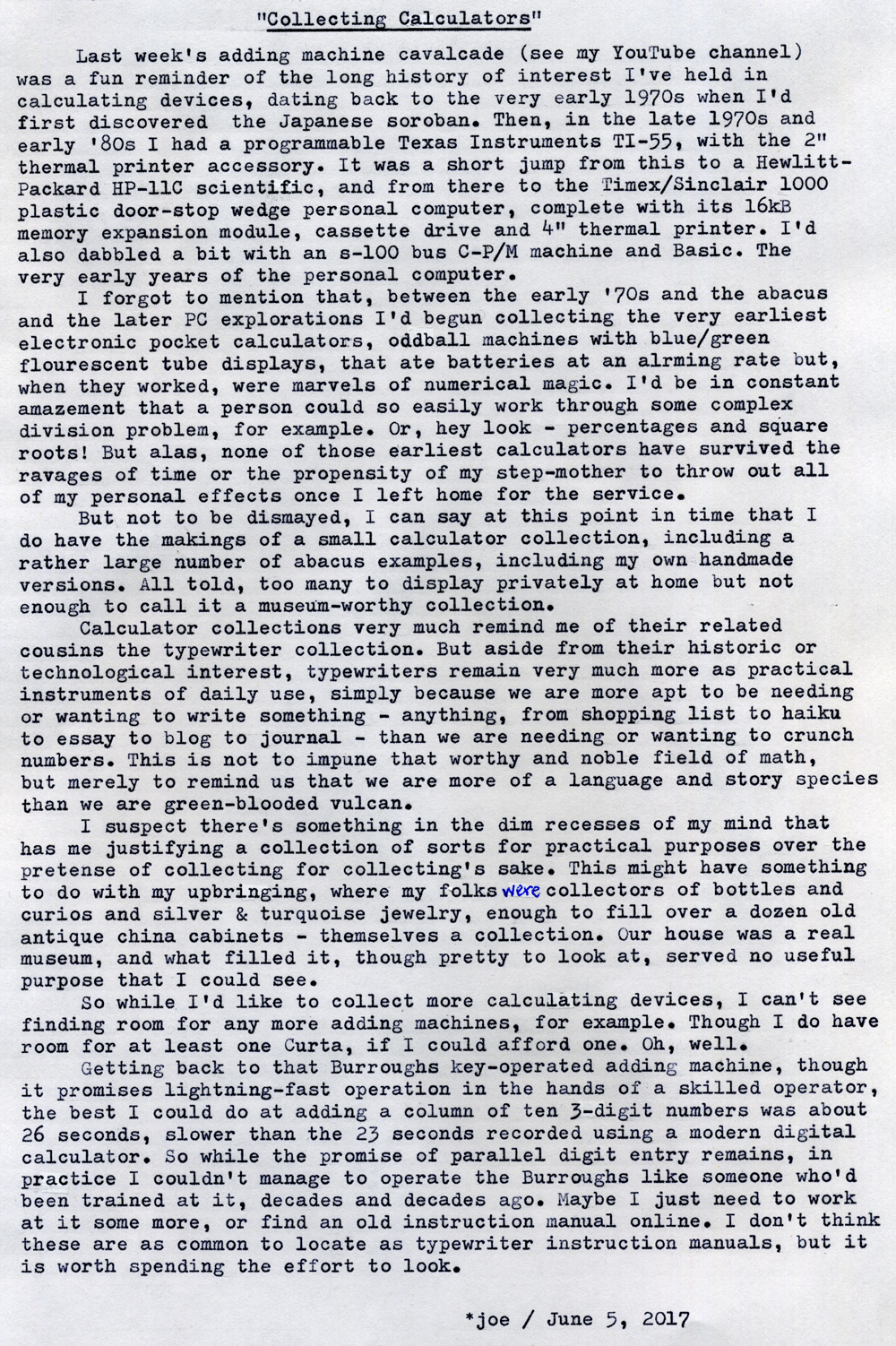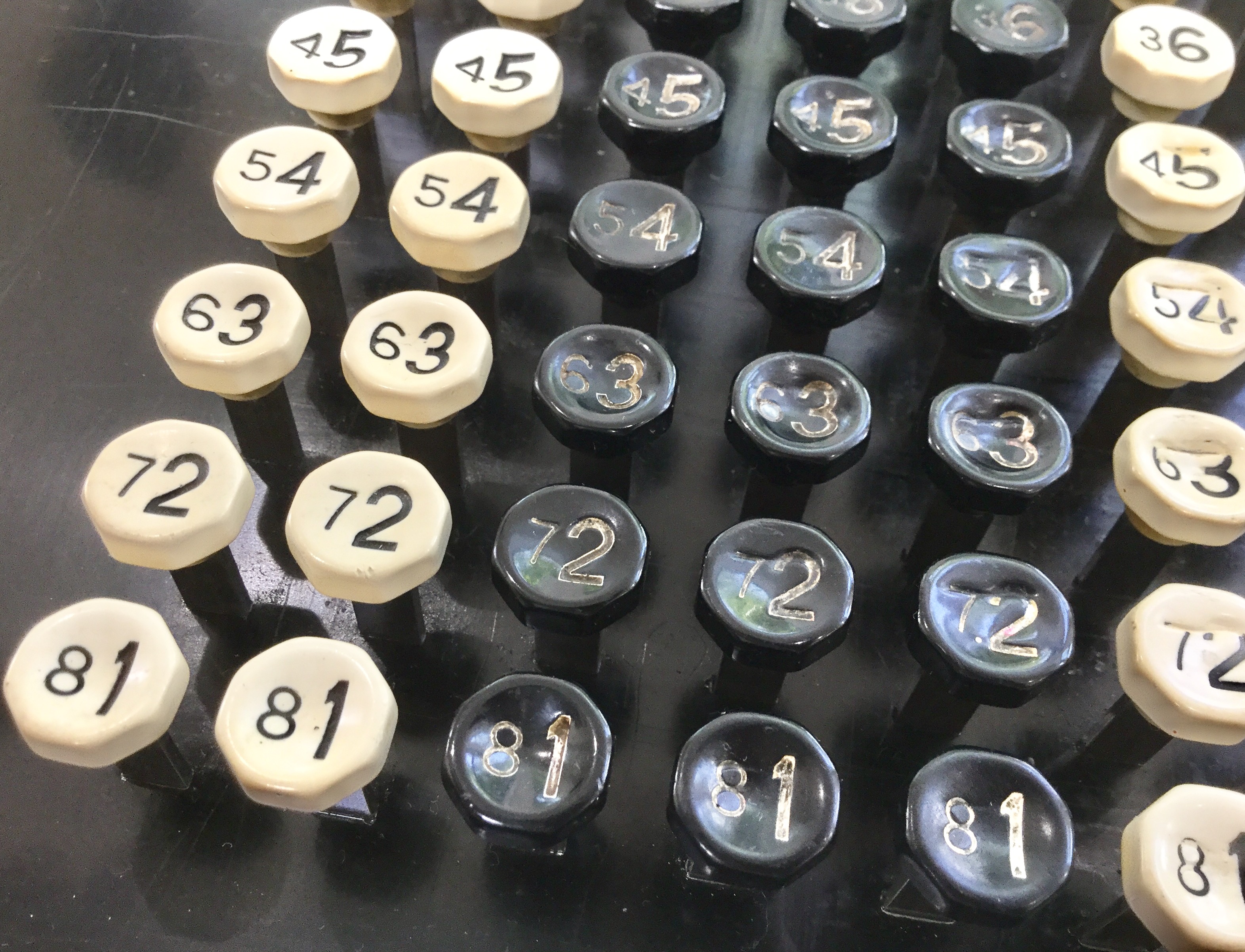What? Another Typewriter? Yes!
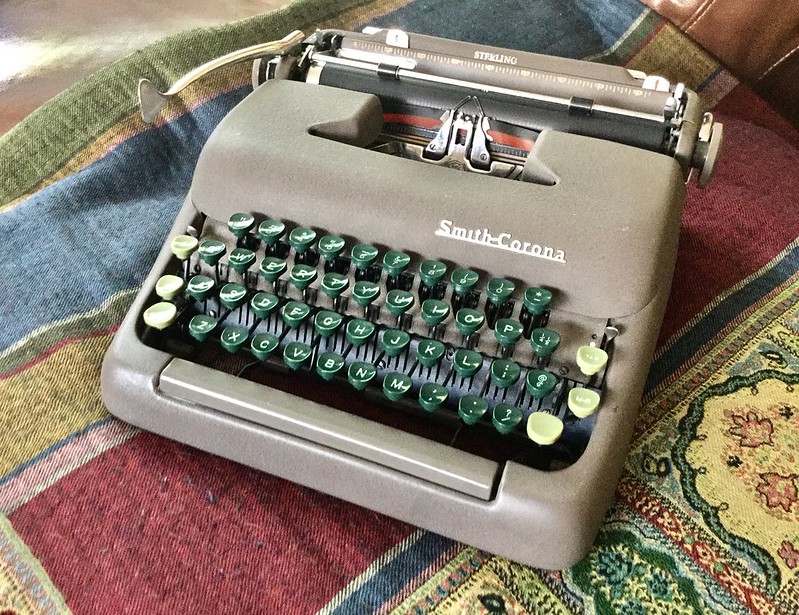
After the Associated Press article on the typewriter revival came out several weeks ago, some people took notice that I live in the local area, including a lady named Sandy, who had in her possession her mother's Smith-Corona Sterling. No, I don't need another typewriter, but this one has an italic typeface. Sandy called me last week, inquiring if I'd care to take it off her hands, and I agreed for her to come over Sunday and I'd take a look at the machine.
I've always been amused by the styling of machines from this era, with their muted colors (or lack thereof) in drab grays and browns, with just a hint of excitement from the two-tone green keys. Automobiles from the same era were similarly adorned in muted color schemes; was it because of some intrinsic modesty, or simple economics? Even the shape of these 5-Series machines reminds me of late-1940s cars, with their rounded curves.
The machine turned out to be entirely functional, excepting the end-of-line bell wasn't working, caused by a bent bracket. And it was very dirty inside, evidence of having never been serviced. Her mother purchased it in 1949 from a small town in Kansas, though it lacks a dealer sticker.
It took me hours and hours to get it adequately cleaned and adjusted. Years of eraser debris had accumulated inside, enough to pit and stain some of the metal surfaces. Extensive cleaning with naphtha and alcohol took care of most of the grunge, however.
The type slugs were caked with old ink and grease, the worse I've seen, and took an extensive session with toothpicks, toothbrush and alcohol to render clean.
Luckily, I have Ted Munk's Typewriter Repair Bible for these 5-Series Smith-Coronas, for I went through the machine, checking in turn each adjustment. It actually wasn't too bad. The right side of the space bar sat lower than the left, which required reforming (i.e. bending) the support arms to get it flush with the body panels, while ensuring adequate travel to trip the escapement, with room to spare. The four screws that hold the space bar to their brackets needed to be loosened and the space bar adjusted to be square to the opening in the body panels.
The other adjustment needed was the tripping point of the type bars. They should trip the escapement to advance the carriage one space when the type slugs just approach the front of the type guide. With this machine, the escapement wouldn't trip until the type slugs were almost in contact with the ribbon. The adjustment involved bending an arm in the escapement mechanism.
As is common with these machines that've never been serviced, some additional degreasing in the slots of the segment were required for some of the type bars, which would subsequently hang up while test typing. I've found that, even if you think the machine is fully functional, you need to do some extensive test-typing to iron out those intermittent problems that remain. I find using disposable mascara brushes, with alcohol, to be a good way to clean the slots of the segment.
I like this italic type face; it's the first in my collection, and the main reason why I purchased this machine. I think it'll be a good letter-writing machine, which is what the lady's mother did, as evidenced by what she told me, and the observation that the right margin was set inward so as to correspond to the width of letter-writing paper.
The Sterling is at the lower end of the 5-Series line. It lacks the end-of-line indicator found on the left end of the platen roller in the higher-end Silents; has fixed tabs with metal slugs that can, if so desired, be set to one's liking; and the platen roller is not easily removable without unscrewing the right carriage cover and loosening a nut.
This machine has a bit more of a mechanical clanking sound to it than the Silents in my collection. Perhaps it's due to being a lower-end model; or because the thin rubber washers originally located on the body panel screw holes have all dissolved into tar. I'll have to find some replacements at the hardware store.
I don't really need another machine in my collection, unless it were highly desirable. This is my third 5-Series machine, which I'll probably keep just for the italic type face. But if I had the opportunity, I'd certainly pick up the little Sky Writer, one of the best ultra-portables.
What I'm thinking of doing with some of these "surplus" or redundant machines in my collection is to donate them to a local school classroom, should I be able to locate a teacher so inclined. I don't want to incur the expense and risk of shipping them out of town, otherwise I'd sell them online.
I think this is a reasonable approach to maintaining a working collection of typewriters, while not permitting them to get out of hand and control my life. As you learn over time your personal preferences, you can adjust your inventory accordingly. Fixing these surplus machines up, then passing them on to others who'd like to experience the manual typewriter lifestyle is our responsibility as aficionados. It certainly beats having them be discarded to the landfill, or be victims of the key-choppers.
One bonus item of Ephemera included with the typewriter was a generic plastic typewriter cover. It's beige in color and in great condition, though lacks any Smith-Corona branding, so I'm thinking it was sold along with the machine by the shop in Kansas. It turns out this cover is large enough that it will serve as a usable cover with even larger machines in my collection, such as the Hermes 3000. Were I of the mind to, and adequately equipped with sewing machine, it'd be nice to use this cover as a template for making colorful cloth covers for sale. I'm just not certain I want to get in the typewriter cover business. But maybe a small sewing machine is in my future. Perhaps.
Post-Script: Written via Alphasmart Neo at my local cigar store lounge. I didn't feel like walking back home in the afternoon heat lugging a typewriter, even a small portable.
Here's my video about this new typewriter to my collection:
Labels: AlphaSmart Neo, Smith-Corona Sterling, Ted Munk, test-typing, typewriter collecting, typewriter ephemera, typewriter renaissance, typewriter repair, Typewriter video series


